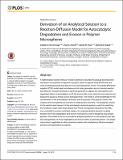| dc.contributor.author | Ford Versypt, Ashlee N. | |
| dc.contributor.author | Arendt, Paul D. | |
| dc.contributor.author | Pack, Daniel W. | |
| dc.contributor.author | Braatz, Richard D. | |
| dc.date.accessioned | 2015-11-10T17:40:35Z | |
| dc.date.available | 2015-11-10T17:40:35Z | |
| dc.date.issued | 2015-08 | |
| dc.date.submitted | 2015-01 | |
| dc.identifier.issn | 1932-6203 | |
| dc.identifier.uri | http://hdl.handle.net/1721.1/99884 | |
| dc.description.abstract | A mathematical reaction-diffusion model is defined to describe the gradual decomposition of polymer microspheres composed of poly(D,L-lactic-co-glycolic acid) (PLGA) that are used for pharmaceutical drug delivery over extended periods of time. The partial differential equation (PDE) model treats simultaneous first-order generation due to chemical reaction and diffusion of reaction products in spherical geometry to capture the microsphere-size-dependent effects of autocatalysis on PLGA erosion that occurs when the microspheres are exposed to aqueous media such as biological fluids. The model is solved analytically for the concentration of the autocatalytic carboxylic acid end groups of the polymer chains that comprise the microspheres as a function of radial position and time. The analytical solution for the reaction and transport of the autocatalytic chemical species is useful for predicting the conditions under which drug release from PLGA microspheres transitions from diffusion-controlled to erosion-controlled release, for understanding the dynamic coupling between the PLGA degradation and erosion mechanisms, and for designing drug release particles. The model is the first to provide an analytical prediction for the dynamics and spatial heterogeneities of PLGA degradation and erosion within a spherical particle. The analytical solution is applicable to other spherical systems with simultaneous diffusive transport and first-order generation by reaction. | en_US |
| dc.description.sponsorship | National Institutes of Health (U.S.) (NIBIB 5RO1EB005181) | en_US |
| dc.description.sponsorship | National Science Foundation (U.S.) (Grant 0426328) | en_US |
| dc.description.sponsorship | United States. Dept. of Energy (Computational Science Graduate Fellowship Contract DE-FG02-97ER25308) | en_US |
| dc.language.iso | en_US | |
| dc.publisher | Public Library of Science | en_US |
| dc.relation.isversionof | http://dx.doi.org/10.1371/journal.pone.0135506 | en_US |
| dc.rights | Creative Commons Attribution | en_US |
| dc.rights.uri | http://creativecommons.org/licenses/by/4.0/ | en_US |
| dc.source | Public Library of Science | en_US |
| dc.title | Derivation of an Analytical Solution to a Reaction-Diffusion Model for Autocatalytic Degradation and Erosion in Polymer Microspheres | en_US |
| dc.type | Article | en_US |
| dc.identifier.citation | Ford Versypt, Ashlee N., Paul D. Arendt, Daniel W. Pack, and Richard D. Braatz. “Derivation of an Analytical Solution to a Reaction-Diffusion Model for Autocatalytic Degradation and Erosion in Polymer Microspheres.” Edited by Zhen Jin. PLoS ONE 10, no. 8 (August 18, 2015): e0135506. | en_US |
| dc.contributor.department | Massachusetts Institute of Technology. Department of Chemical Engineering | en_US |
| dc.contributor.mitauthor | Ford Versypt, Ashlee N. | en_US |
| dc.contributor.mitauthor | Braatz, Richard D. | en_US |
| dc.relation.journal | PLOS ONE | en_US |
| dc.eprint.version | Final published version | en_US |
| dc.type.uri | http://purl.org/eprint/type/JournalArticle | en_US |
| eprint.status | http://purl.org/eprint/status/PeerReviewed | en_US |
| dspace.orderedauthors | Ford Versypt, Ashlee N.; Arendt, Paul D.; Pack, Daniel W.; Braatz, Richard D. | en_US |
| dc.identifier.orcid | https://orcid.org/0000-0003-4304-3484 | |
| mit.license | PUBLISHER_CC | en_US |
| mit.metadata.status | Complete | |
